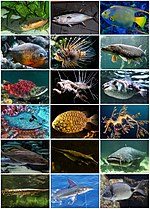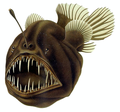Greek teleios "complete" + osteon "bone"), members of which are known as teleosts (/ˈtɛliɒsts, ˈtiːli-/), is, by far, the largest infraclass in the class...
97 KB (10,118 words) - 18:57, 5 July 2024
pelvic and pectoral girdles). The vast majority of actinopterygians are teleosts. By species count, they dominate the subphylum Vertebrata, and constitute...
48 KB (3,773 words) - 12:34, 29 July 2024
CCGS Teleost is a Canadian Coast Guard fisheries research vessel. The ship was originally constructed in Norway in 1988 as a commercial fishing trawler...
8 KB (670 words) - 19:18, 19 February 2024
Teleost hatching enzyme may refer to: Choriolysin L, an enzyme Choriolysin H, an enzyme This disambiguation page lists articles associated with the title...
119 bytes (47 words) - 15:23, 30 December 2019
Teleost leptins are a family of peptide hormones found in fish (teleostei) that are orthologs of the mammalian hormone leptin. The teleost and mammalian...
30 KB (3,213 words) - 16:43, 24 March 2024
anglerfish, and pufferfish. Percomorpha are the most diverse group of teleost fish today. Teleosts, and percomorphs in particular, thrived during the Cenozoic era...
27 KB (624 words) - 16:46, 1 June 2024
lobe-finned and ray-finned fish. About 96% of all living fish species today are teleosts, a crown group of ray-finned fish that can protrude their jaws. The tetrapods...
102 KB (10,216 words) - 05:43, 30 July 2024
The anglerfish are fish of the teleost order Lophiiformes (/ˌlɒfiɪˈfɔːrmiːz/). They are bony fish named for their characteristic mode of predation, in...
47 KB (4,906 words) - 09:13, 3 August 2024
cannibalism is particularly common in teleost fishes, appearing in at least seventeen different families of teleosts. Within this diverse group of fish,...
42 KB (5,068 words) - 17:44, 21 June 2024
Xeneichthys is an extinct genus of Teleost fish from the Albian El Doctor Formation in Hidalgo, Mexico. The type and only species is X. yanesi is known...
2 KB (143 words) - 00:43, 23 July 2024
Interferon (section Teleost fish interferons)
Interferons (IFNs, /ˌɪntərˈfɪərɒn/ IN-tər-FEER-on) are a group of signaling proteins made and released by host cells in response to the presence of several...
62 KB (7,065 words) - 05:17, 28 June 2024
while other seed plants (gymnosperms and seed ferns) decline. More modern teleost fish begin to appear. Ammonoids, belemnites, rudist bivalves, sea urchins...
172 KB (9,499 words) - 11:31, 1 August 2024
Serotonin (section Teleost fish)
teleost fish also possess 5-HT cells in other sections of the brain, including the basal forebrain. Danio rerio (zebra fish) are a species of teleost...
129 KB (13,965 words) - 22:04, 4 August 2024
A. (2001). "The evolution of electroreception and bioelectrogenesis in teleost fish: a phylogenetic perspective". Journal of Fish Biology. 58 (6): 1489–1511...
9 KB (478 words) - 10:12, 1 August 2024
necessary for hearing on dry land. An affinity between the amphibians and the teleost fish is the multi-folded structure of the teeth and the paired supra-occipital...
161 KB (17,922 words) - 14:21, 2 July 2024
Ependymin is a glycoprotein found in the cerebrospinal fluid of many teleost fish. The humans homolog is called ependymin related 1 that is encoded by...
5 KB (485 words) - 14:17, 29 March 2024
Teleosteomorpha is a clade of ray-finned fishes containing all teleost fish and their closest extinct relatives. Also in this group are two diverse Mesozoic...
16 KB (1,023 words) - 17:44, 18 March 2024
found in all tetrapods and also in teleosts, although its form and length vary enormously between species. In teleosts, it is relatively short, typically...
30 KB (3,454 words) - 05:39, 14 July 2024
and order names. Salmonids have a relatively primitive appearance among teleost fish, with the pelvic fins being placed far back, and an adipose fin towards...
24 KB (2,184 words) - 09:38, 25 May 2024
the K–Pg extinction killed off plesiosaurs and mosasaurs and devastated teleost fish, sharks, mollusks (especially ammonites, which became extinct), and...
170 KB (18,690 words) - 07:25, 26 July 2024
Apparent death (section Teleost fishes)
Apparent death is a behavior in which animals take on the appearance of being dead. It is an immobile state most often triggered by a predatory attack...
48 KB (5,469 words) - 23:10, 4 August 2024
scales for Osteichthyes which are cosmoid scales, ganoid scales, teleost scales. The teleost scales are also then divided into two subgroups which are the...
32 KB (2,188 words) - 10:41, 4 August 2024
it too during the Late Cretaceous. In the seas, rays, modern sharks and teleosts became common. Marine reptiles included ichthyosaurs in the early and mid-Cretaceous...
95 KB (9,847 words) - 18:37, 18 July 2024
sharks can contract and dilate their pupils, like humans, something no teleost fish can do. Sharks have eyelids, but they do not blink because the surrounding...
143 KB (14,287 words) - 17:03, 31 July 2024
complex and unstable patterns of gene flux have been observed in cichlid teleosts of the East African Great Lakes. Wilkins argued that "if we were being...
103 KB (10,508 words) - 07:46, 31 July 2024
the foregut). Birds, for example, typically have three such ducts. In teleost fish, and a few other species (such as rabbits), there is no discrete pancreas...
50 KB (5,610 words) - 14:40, 4 August 2024
Bothriocephalidea (crustaceans [→ teleost] → teleost fishes/amphibians)...
22 KB (2,055 words) - 00:08, 14 July 2024
Durophagy (section Teleost fish (Teleostei))
mandibles, while bonecrackers have more sophisticated premolars. Many Teleosts, for example the Atlantic wolffish, exhibit durophagous behaviour and crush...
20 KB (2,683 words) - 13:48, 2 June 2024
conserved patterns of vocal, auditory, and neuroendocrine mechanisms between teleosts and tetrapods, which include midshipman fish and humans, respectively....
17 KB (2,105 words) - 18:22, 4 August 2024
impairments in spatial memory. The story for fish is more complex. In teleost fish (which make up the great majority of existing species), the forebrain...
127 KB (14,832 words) - 09:36, 11 July 2024




























